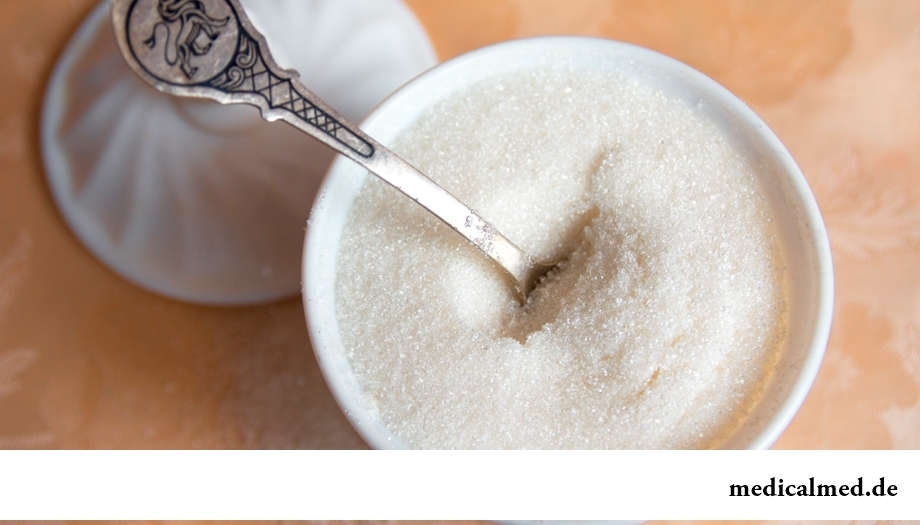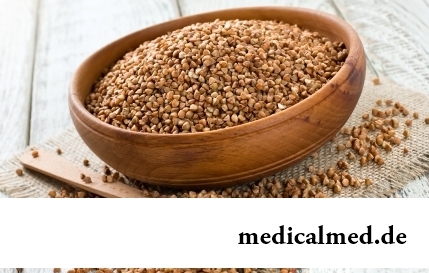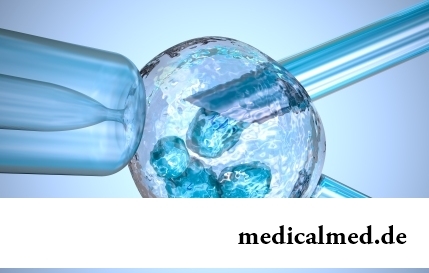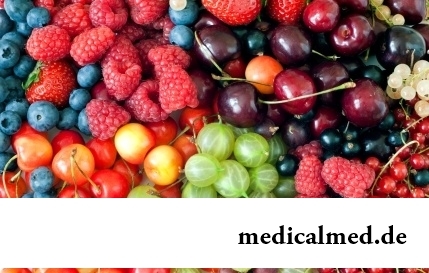





Sugar
Sugar – high-calorific foodstuff. According to people annually uses about sixty kilograms of this carbohydrate.

India where it is known about 2500 is considered the homeland of a product. Particles of brown color made of a sugarcane and delivered to the European countries from India. Egypt acted as the intermediary in this trade.
In Russia it for the first time appeared approximately in the 11th century. At that time only the tsar and his confidants could use this valuable product.
In 1802 arranged production of sugar from beet near Tula in the beginning, and then and in other regions of the country.
On structure and properties sugar is divided into disaccharides, monosaccharides and polysaccharides.
Are ranked as monosaccharides fructose (fruit sugar), a dextrose or glucose (glucose) and a galactose. The maltose (malt sugar), lactose (milk sugar) and sucrose (cane and beet sugar) belong to disaccharides. Intestines of the person acquire only monosaccharides.
Now sugar of different types – palm, reed, beet, white and brown is produced. All its types release in the cleared and crude look.
The refined (purified) sugar is subjected to steam processing, turned into syrup and filtered then it turns the beautiful white weight which is evaporated, and then dried up.
Honey – a special type of sugar. It contains about 20% of water, microelements and mineral substances and about 80% of sugar in the form of sucrose, glucose and fructose.
Properties of sugar of brown color, useful to human body, are explained by the maintenance in it of molasses and the whole complex of useful components. Though the indicator of caloric content of sugar of brown color is much higher, than white.
There are following types of sugar: baking, fruit, usual, crystal, ultrasmall, rough, liquid, confectionery powder and sugar sprinkling.
Granulated sugar and sugar in the form of lump sugar are most known among consumers. Are considered less popular lump and candy sugar. Most often they move at restaurants to various drinks.
Nutrition value and caloric content of sugar
Hundred grams of this sweet product contain 99,8 g mono - and disaccharides, 0,1 g of ashes, 0,1 g of water, 3 mg of calcium, 0,3 mg of iron, 3 mg of potassium and 1 mg of sodium.
Sugar caloric content – 399 kcal on 100 g of a product. Scientists consider that daily women can use no more than four teaspoons of this product, to men – no more than six spoons, and to children – one teaspoon a day.
Useful properties of sugar
The important advantage of sugar consists in its ability to activate blood circulation in back and a brain. Among scientists there is an opinion that sugar brings undoubted benefit at diseases of a spleen and liver as glucose supports barrier function of a liver, participating in synthesis of glucuronic and pair sulphuric acids.
This product indirectly increases emission in a serotonin brain - "hormone of good mood".
Sugar is considered one of the main sources of carbohydrates for a human body. It is possible to refer to advantage of sugar that this sweet product sates muscles of the person with necessary energy, eliminates a headache, removes fatigue for a short span.

Harm of sugar
Speaking about harm of sugar, it is necessary to remember that this product happens internal and external.
The first contains in cereals, fruit, some vegetables. Sugar of this type is not considered harmful as in a human body he is late in the quantity necessary for normal life activity.
External sugar contains in treacle, cakes, candies, drinks and other sweet dishes. The use of sugar of this type in a large number harms an organism.
The white purified sugar from beet or reed does not contain cellulose, vitamins, proteins and minerals. This product for 99% is pure simple carbohydrate.
Sugar at hit in a body at once comes to a blood plasma. It is soaked up in blood so quickly that it demands excessive concentration of insulin. The sharp jump of level of insulin leads to reduction of concentration of this carbohydrate in blood therefore the hypoglycemia develops. The similar state is shown in increased fatigue, decline of energy, slowness of movements, dizziness, anemia, low pressure, blackout, a hair loss, cyanosis.
The greatest harm of sugar is that it brings out of an organism calcium, and also other minerals, absorbs valuable nutrients, the protein stock exhausts. All this leads to development of caries, rickets, osteoporosis – painful destruction of bones.
Sharp increase and sharp recession of concentration of glucose in blood causes feeling of false hunger.
Consumption of a protein in enough and overconsumption of sugar leads to development of obesity, and a lack of a protein of an organism and overconsumption of sugar becomes very frequent the leanness reason.
The excessive use of sugar reduces force of immune system by seventeen times. The London doctors found out that this sweet product is capable to change partially bacteria on a mucous membrane of walls of intestines. It leads to disintegration of salts of bile and formation of the substances causing cancer diseases.
Cardiovascular diseases are caused by a combination of sugar and fats of animal origin which are postponed on walls of arteries in the form of cholesterol.
The excessive use of sacchariferous products increases risk of development of a diabetes mellitus, diseases of a brain, blood, and also promotes a senilism. Carbohydrate is laid in skin collagen, reducing its elasticity.
The use of sugar promotes education of harmful free radicals who kill a human body from within.
Having fallen from a donkey, you more likely will kill yourself, than having fallen from a horse. Only do not try to disprove this statement.

So, you resolved to lose weight. And now you try to understand what to begin with: from exercise stresses or a diet? And how to make, h...
Section: Slideshow
Each woman has preferences in the field of use of those goods which help us to look good, feel young and effective. Besides: selection process of favourite perfume, shampoo or decorative cosmetics already lifts a spirit...
Section: Articles about health
Each person knows that fervescence is an illness sign. However too low temperature (hypothermia), especially also can demonstrate existence of diseases when it is observed long enough. Such state is dangerous that it, unlike fever, does not give a serious inconvenience: patients usually complain only of weakness, drowsiness, apathy. Sometimes the fever and a cryesthesia in extremities joins. Many people at similar symptoms...
Section: Articles about health
People know that thermal sources have salutary force long ago. Treatment by natural waters is one and...
Section: Articles about health
Herpes simplex of the first type (the infectious disease which is shown periodic bubble rashes on lips is called) – one of the most widespread illnesses. Statistically, only 5% of inhabitants of our planet are unreceptive to its activator, and...
Section: Articles about health
Cold – a state known to everyone which is followed by cold, cough, high temperature, a pharyngalgia. Often the first that we begin to do in hope again to become healthy – to accept medicines which are not always harmless whereas it is easy to facilitate displays of a disease by means of natural means. They not only softly eliminate disease symptoms, but also enrich the weakened organism with useful substances. We present you 8 drinks which are successfully used for...
Section: Articles about health
The modern person not always manages to find housing in the environmentally friendly region and such work which would not do harm здо...
Section: Articles about health
The technique of acupuncture (acupuncture) is used in the medical purposes more than three and a half millennia. It is eurysynusic and recognized as official medicine in the majority of the developed countries of the world. Influence by fine needles on so-called points...
Section: Articles about health
Good appetite was always considered as a sign of good health. The correct operation of the mechanism which is responsible for the need for nutrients and receiving pleasure from process of its satisfaction demonstrates that the organism functions without special deviations. On the other hand, appetite of the person is not a constant. It depends on the culture of food, flavoring addictions imparted since the childhood which can change during life, weather, mood and many д more than once...
Section: Articles about health
Helminthosis is one of the most widespread diseases. Statistically, with any species of helminths it is infected porridges...
Section: Articles about health
Run - one of the most available and effective ways to revitalize the organism. Knowing about its extraordinary advantage, each of us at least once tried to make jogs, but only the few made these occupations regular. In spite of the fact that in jogging (easy an ozdor...
Section: Articles about health
Epilepsy is one of widespread neurologic diseases. Parents, whose children suffer from this illness, should face rumors and delusions, many of which remained since the Middle Ages....
Section: Articles about health
Among a set of the perfumery and cosmetic goods which are released today the special group is made by the means containing anti-bacterial...
Section: Articles about health
Neurosis is called pathology of a nervous system at which deviations in functioning of the highest nervous processes are observed. Most often - owing to yet not strengthened mentality - children are subject to neurosises. Premises to emergence of such disturbances can become нез...
Section: Articles about health
According to World Health Organization, every third inhabitant of Earth has excess weight, and every tenth has obesity. The reason of this phenomenon, according to specialists, roots in one not very comforting fact: most of people consume much more calories, than it is necessary. How it turns out what we overeat? Why it is so difficult to refuse an excess portion tasty or additives? Let's try to find out what factors prevent us to eat food with reasonable moderation....
Section: Articles about health
Any of us is not insured from a heavy illness of the loved one. Happens and so that someone from family members becomes lying бо...
Section: Articles about health
History of cultivation of a buckwheat contains more than five thousand years. Grain which is received from this plant is used for preparation of porridges, soups, baked puddings and puddings, do flour which is one of the main ingredients of the noodles popular in of it...
Section: Articles about health
The unpleasant feelings connected with spring breakdown are familiar almost to each of us. Often happens that in March-April on the person weakness leans: he suffers from drowsiness, complains of bad mood, loss of interest in life and failures in affairs....
Section: Articles about health
Extracorporal fertilization – one of the most modern methods of controlling with infertility. So far it already helped znach...
Section: Articles about health
The medicine promptly develops, and the fact that else quite recently it seemed by miracle can now. We are not surprised any more to the fact that people with artificial joints and extremities can play sports, organ transplantation became a routine, and the latest cancer medicine п...
Section: Articles about health
Proofs of efficiency of Mildronate at treatment of coronary heart disease with stenocardia can be found in many publications of the end of the twentieth century. Researches were conducted since 1984, including placebo - controlled effects. In total clinical tests of Mildronate were carried out for more than thirty years....
Section: Articles about health
History of use of an anesthesia during operations contains more than 160 years. Annually in the world hundreds of thousands surgical вм are carried out...
Section: Articles about health
Contrary to popular belief, the multiple sclerosis (MS) is not connected neither with sclerous changes of walls of vessels, nor with age forgetfulness and problems with concentration of attention. This disease has the autoimmune nature. Pathological process of a vyrazh...
Section: Articles about health
EKO, or extracorporal fertilization - a method of treatment of infertility which became the reason of a set of broken-down copies in due time accused the people working on its creation neither more nor less of rivalry good luck. Already very few people deny the right of a method for existence, and to surprise nobody with "children from a test tube". And nevertheless, a certain magic in the procedure of artificial fertilization is, process of origin of new life is always a secret, and even it р now...
Section: Articles about health
All got used long ago that, having addressed the plastic surgeon, it is possible to modify natural parameters of a figure or to reduce...
Section: Articles about health
Visit of doctors – business not the most pleasant, and many people do not hurry to undergo necessary planned inspections. Such behavior is extremely thoughtless and improvident. Our health is necessary not only to us: wellbeing of darlings, children, grandsons and престар...
Section: Articles about health
All the known slogan "Protect Men!" arose not from scratch. In a sense, the nature created men much less adapted for vital disorders, than it seems at first sight. Statistically, men are ill more often, than women, have the majority of illnesses heavier and earlier die. The situation is aggravated with the fact that our fathers, husbands, brothers and sons are not always inclined to care for the health. Partly it happens because of unwillingness of t...
Section: Articles about health
